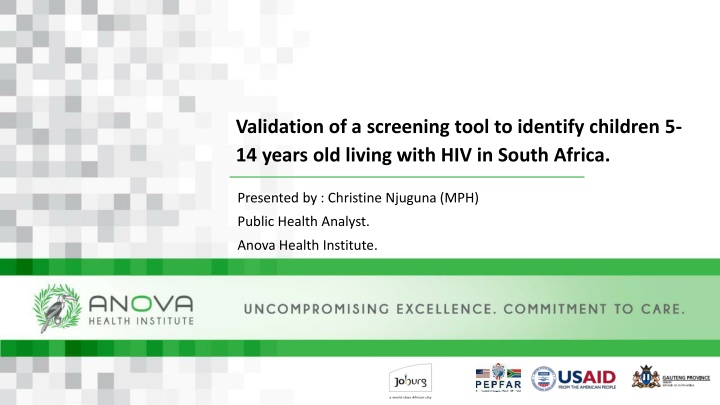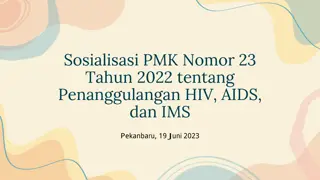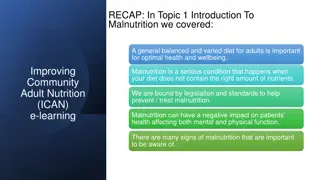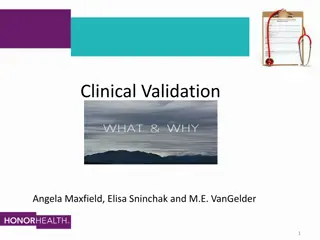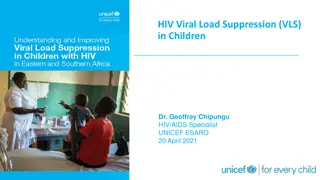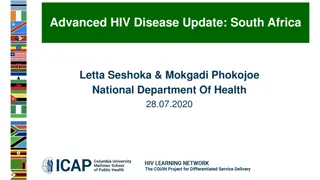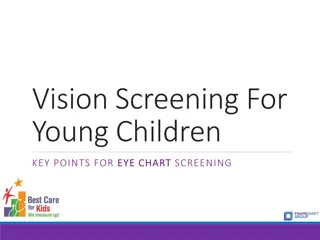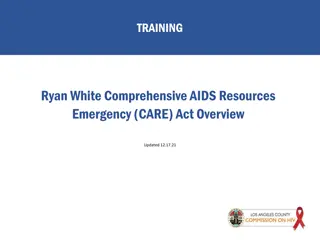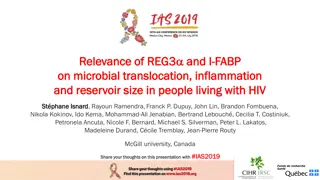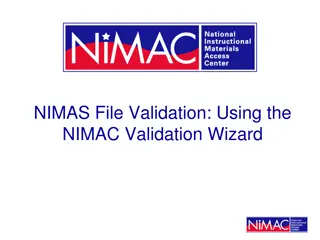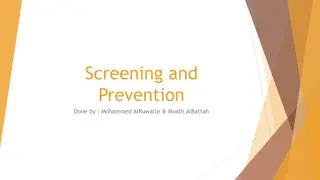Validation of a Screening Tool for Children Living with HIV in South Africa
Christine Njuguna, MPH, presents a study on validating a screening tool to identify children aged 5-14 living with HIV in South Africa. The research aims to improve focused HIV testing and increase case finding among untreated children in the specified age range. The study background, objectives, methods, and preliminary results are outlined, emphasizing the importance of early diagnosis and intervention.
Download Presentation

Please find below an Image/Link to download the presentation.
The content on the website is provided AS IS for your information and personal use only. It may not be sold, licensed, or shared on other websites without obtaining consent from the author.If you encounter any issues during the download, it is possible that the publisher has removed the file from their server.
You are allowed to download the files provided on this website for personal or commercial use, subject to the condition that they are used lawfully. All files are the property of their respective owners.
The content on the website is provided AS IS for your information and personal use only. It may not be sold, licensed, or shared on other websites without obtaining consent from the author.
E N D
Presentation Transcript
Validation of a screening tool to identify children 5- 14 years old living with HIV in South Africa. Presented by : Christine Njuguna (MPH) Public Health Analyst. Anova Health Institute.
Presentation outline 1 Study background and rationale 2 Study Objectives 3 Study methods 4 Preliminary results 5 Conclusions 6 Funding sources 7 Acknowledgements
Study background and rationale (SA; Sept 21) HIV prevalence Treatment gap 0-<5 years 0.7% 18 200 5-<14 years 1,9% 99 400 Most untreated HIV positive children are between 5-14 years (85%). PMTCT has been successful However, this was not the case 10-15 years ago. Children under 5 years have low HIV prevalence and have also been exposed to more comprehensive early infant diagnosis (they have been found). Children 5 and older may have missed out on PMTCT / not been fully tested in infancy and post-breastfeeding. Adolescents 15 years and older are more likely to be sexually active and to be tested for HIV through facility and community testing. Some HIV-infected children grow into late childhood / early adolescence without being diagnosed, despite having suffered periods of ill health. Medical Research Council. (2020). South Africa District HIV Estimates. Retrieved September 14, 2021, from HIVData website: https://www.hivdata.org.za/
Background- Origins of the screening tool. This screening tool was designed to improve focussed HIV testing in children 5-14 years Decrease the number of children needing testing Increase case finding of HIV positive cases NDOH Guidelines IMCI While it originates from other validated tools, it has not been validated in the South African setting Validated screening tool
Study Objectives Research: To validate the existing screening tool Aim: Prevalence: 1.5% Produce a validated screening tool that is nationally representative and can be adopted by the NDoH Sample size: 61 HIV + children (Aimed to test 7 700 children to account for possible lower yield)
Study methods Study Setting PHCs in City of Johannesburg (20 PHCs) and Mopani District (7 PHCs). Sub- district A A A A D D D D D D Clinic DiepslootClinic Ebony Clinic Hikhensile Clinic OR Tambo CHC Chiawelo CHC Lillian Ngoyi Community Health Centre Mandela Sisulu Clinic Meadowlands Zone 2 Prov Clinic Michael Maponya Prov Clinic Orlando Prov Clinic Clinic Sub-district Motupa Clinic Nkowankowa CHC Greater Tzaneen Greater Tzaneen Dzumeri CHC Greater Giyani Zola CHC Alexandra 8th Avenue Clinic Alexandra Community Health Centre 17 Esselen Street Clinic Hillbrow Community Health Centre Yeoville Clinic ImbalenhleClinic Lenasia South CHC Orange Farm Ext 7 Clinic Stretford CHC D E E F F F G G G G Giyani CHC Greater Giyani Sekgopo Clinic Greater Letaba Lulekani CHC Ba-Phalaborwa Befarm Clinic Ba-Phalaborwa
Study methods Inclusion Criteria Children 5 to 14 years of age. Children presenting with their mother, legal guardian or an appropriate caregiver in the case of a deceased mother. Exclusion Criteria HIV positive children. Children with documented negative HIV test in the last 6 months. Very ill children or those who need immediate care or transfer.
Study methods Study Recruitment At 1.5% yield, target of 61 positive children predicted to be met in 6 months. Aimed to enrol 7700 (at 1.5% yield this would have been 116 HIV positive children) However, current yield is 0,5%- so target of 61 positive children to be met in 12 months. Study team Existing HTS team Study team
Preliminary results Total of 10,861 children recruited between 21 June 2021 and 1 April 2022 . 9381 (86,4%) from COJ & 1480 (13,6%) from Mopani District. 10,797 (99,4%) had an HIV test done, 53 (0,5%) children tested positive. Demographic & clinical characteristics of HIV-positive children Of the 53 HIV-positive children, 37 were in COJ District (69,8%; yield 0,4%), 16 were in Mopani District (30,2%; yield 1,1%). Median age of HIV-positive children-9yrs, majority female, 28 (52,8%). 41 (77,4%) were HIV-exposed, whilst 12 (22,6%) were HIV un-exposed or unknown HIV exposure. Most, 33 (62,3%) HIV-positive children recruited from Acute/Casualty- child is sick.
Preliminary results- screening tool Overall, 58,1% (6243/10,744) HIV-negative children answered yes to at least 1 screening question. 90,6% (48/53) HIV-positive children answered yes to at least 1 screening question. Screening question Is the parent/sibling of child HIV-positive? Has the parent/sibling of child died? Has the child been abandoned? Has the child ever been diagnosed with TB? Has the child had poor health in last 3 months? Has the child ever been admitted to hospital? Is there low weight/poor weight gain? Is the child stunted or short for age? Has the child ever had ab ear discharge? Does the child have recurring skin problems (rashes)?15 (28,3%) (N=53) 47 (88,7%) 12 (22,6%) 5 (9,4%) 1 (1,9%) 27 (50,9%) 14 (26,4%) 17 (32,1%) 9 (17,0%) 7 (13,2%)
Conclusions Efforts to target HIV case-finding in children are needed. Majority of HIV-positive children were recruited from Acute/Casualty- child is sick. Most children testing HIV-positive were HIV-exposed. A screening tool to identify children needing testing will focus testing resources. When the study is complete, the screening questions will be analysed for sensitivity and specificity and combined into an optimal tool.
Funding sources This study was funded through the generous contribution of ELMA Philanthropies and Anova Health Institute.
Acknowledgments All the caregivers and children who consented to participate in this study. All HIV Counselling and Testing personnel at the PHCs who conducted the HIV testing. All Research Assistants and Paediatric CLOs who have collected the data. The professional nurse and rest of the study team who have contributed towards the co-ordination of the study and preliminary data analysis. All staff personnel at clinics who have helped facilitate this study. COJ District and Mopani District for providing permission to conduct the study in the PHCs.
